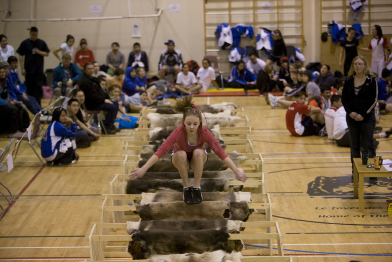Module 7
1. Module 7
1.38. Page 5
Module 7: Trigonometry
Lesson 7 Summary

© Sol Neelman/Corbis/All rights reserved.
One of the events of the Arctic Winter Games is the sledge jump. For this event, ten sledges are arranged in a row. The athlete must first jump over each of the lined-up sledges and then, with one additional jumping motion, turn around to jump over the sledges again in the opposite direction.
If you have competed in similar events, either locally or nationally, you know the pride these athletes must feel in their accomplishments!
If you have selected a sport as the focus of your Unit 3 Project, and if you have chosen trigonometry as the mathematics concept you want to develop, now is the time to complete this part of your project.
Take pride in everything you do!
In this lesson you explored this question:
-
How are the appropriate trigonometric ratios identified and applied to a variety of practical problems?
Check your level of understanding of the materials covered in this lesson by completing “Lesson 7 Traffic Lights.” If you select an amber or red traffic light in the multimedia piece, you will receive information about additional work you can complete to improve your understanding of the topics. Complete the suggested work before you proceed to the Lesson 7 Assignment. If you experience difficulty, contact your teacher before starting the Lesson 7 Assignment.
To answer these questions, you reviewed the definition of the sine, cosine, and tangent functions. You used these ratios to solve for unknown sides and angles in right triangles and to investigate a variety of practical problems.
 Assignment
Assignment
Retrieve the Lesson 7 Assignment Booklet you saved in your course folder at the start of this lesson. Complete the Assignment.
Resave your Assignment Booklet in your course folder and submit a copy to your teacher for assessment.
Unit 3 Project
By now you should have completed Part A of the Unit 3 Project. Throughout all the lessons in Unit 3, you have been instructed to find examples of the different geometric principles and to connect these to examples in your chosen topic.
It is now time to begin working on Part B of the Unit 3 Project. Think of one specific problem or challenge related to your topic that a knowledge of geometry can help to solve.
For more information about this step, refer to the Unit 3 Project.